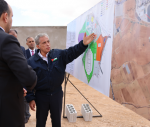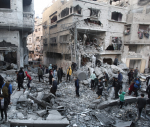You are here
Use of coal brightens Lafarge Cement Jordan’s performance
By Samir Ghawi - May 09,2015 - Last updated at May 09,2015

AMMAN — Using coal at its Rashadiyeh plant marked a significant turnaround for Lafarge Cement Jordan.
Cementing its return to profitability at the end of 2014, the company boosted gross profit during the first quarter of this year by 633 per cent to JD4.4 million from JD0.6 million at the end of March 2014 despite lower sales which dropped to JD22.2 million compared to JD25 million during the first three months of last year.
After taking into consideration administrative, selling, marketing and other expenses, Lafarge Cement Jordan turned the JD2.1 million loss recorded during the first quarter of last year into a JD1.9 million operational profit as of March 31, 2015.
With further reductions, arising from JD0.9 million (JD1 million as of March 31, 2014) in financing costs and JD0.8 million (JD1.2 million) in legal expenses among others, or further earnings arising from the sale of property, equipment and machinery for JD400,000 million among others, the company emerged from the JD4.4 million loss as of March 31, 2014 posting a JD 400,000 million net pretax profit during the first three months of this year.
"After three years of losses, the company was able to achieve JD3.4 million net after–tax profit in 2014 compared to a JD26.2 million net loss recorded in 2013," Lafarge Cement Jordan Chairman Neil Curtis told the shareholders in the 63rd annual report.
In 2012, the net loss was JD19.7 million.
Curtis attributed last year's positive outcome to stringent measures taken by the company, foremost of which was starting to use coal at the Rashadiyeh factory at the end of 2013 in addition to continued tough controls on spending.
"Yet, the company still suffers from unfair competition because, without scientific justification, Lafarge Cement Jordan is not allowed to use coal at its Fuheis factory and, as such, the firm was compelled to discontinue production there for the past two years," he wrote in a foreword.
Toufic Tabbara, chief executive officer for cement and concrete in Jordan, indicated in a separate address that lower production costs and higher sales were the two factors that positively influenced the results last year.
"In 2014, the company strived painstakingly to maintain its position in the cement market," he said. "This perseverance reflected directly on the financial results proving Lafarge Cement Jordan's capability to emerge from financial hardships of previous years.
The chief executive officer credited the coal mill at the Rashadiyeh factory for substantially reducing Lafarge Cement Jordan's costs and boosting its competitiveness in the face of others that have been using coal for several years.
Within this context, he mentioned that production using fuel oil became unfeasible at the Fuheis plant and that shifting to coal was not allowed, describing this obstruction as unfair.
Tabbara also described the production stoppage at the Fuheis factory as detrimental and adverse in terms of burdening the company with higher transportation costs from the Rashadiyeh plant to the main cement consumption market.
Besides the disadvantage from being unable to use coal at Fuheis, Tabbara expected a sharpening competition in 2015 as a result of global economic changes, especially the acute fall in fuel prices, and imports from neighbouring countries where energy costs are much lower.
He stressed the importance of operating cautiously and alertly this year to preserve the 2014 accomplishments, especially with the negative impact from higher electricity and water charges and from imperfect competitiveness due to the misfortune at Fuheis.
The annual report listed the following risks facing the company: Continued rise in energy prices and raw materials; allowing the continuation of clinker and cement imports; the limited Jordanian market where five companies produce cement; and the impact of economic slowdown on the cement market.
Financially, the performance last year was marked by a 24.9 per cent increase in sales which reached JD114.3 million, JD65.5 million of which came from cement business, and JD48.8 million from ready mix (concrete).
Geographically, Aqaba contributed JD5.5 million of the total sales.
Gross profit amounted to JD20.5 million compared to a JD10.6 million loss in 2013 when costs totaling JD102.1 million exceeded sales which came at JD91.5 million.
The gross profit in 2014 turned into a JD9.1 million operational profit and a JD3.4 million after-tax profit when several expenses or income were taken into consideration, chiefly among them JD3.1 million in financing costs and JD3.8 million in legal expenses.
With the improved performance, following a JD21 million operational loss and JD27.5 million net pretax loss in 2013, Lafarge Cement Jordan doled out JD13.7 million (JD9.4 million) to the state treasury in the form of taxes and fees.
The balance sheet as of December 31, 2014 showed that accumulated losses amounted to JD22.8 million, and that the mandatory and voluntary reserves were JD27 millions and JD13.4 million respectively.
Out of JD190.3 million in total assets, JD62.6 million were current assets, mainly inventory and receivables, and JD109.3 million were fixed assets, particularly property, equipment and machinery.
Short and long-term debt to banks totaled JD14.7 million (JD22.6 million), noting that Arab Bank, Housing Bank, Arab Banking Corporation, Jordan Kuwait Bank and Union Bank have credit lines extended to the company.
Other data showed JD20.4 million as the balance related to the obligation for employees' retirement health insurance benefits.
For a number of years until 2009, Lafarge Cement Jordan distributed JD39.4 million in cash dividends to shareholders at a rate of 65 per cent. The company's share price, which traded at JD13.800 in 2006, is at present trading at around JD1.700.
Lafarge, a French company, owned 50.275 per cent of the Jordanian public shareholding company whose labour force comprised 575 employees at the end of last year. The Social Security Corporation had a 21.8 per cent stake, and Moroccan national Mayloud Shoaiby had 10.3 per cent.
Related Articles
Jordan Lafarge Cement Factories Company announced on Wednesday that it generated JD3.4 million in net profit last year, compared to JD26.2 in losses incurred in 2013.
AMMAN – Lafarge Jordan on Monday said that its shareholders have unanimously approved the company's future development plans that include tu
AMMAN — The General Association for Construction Workers on Sunday rejected Lafarge Jordan’s decision to give workers at its Fuheis cement f
















